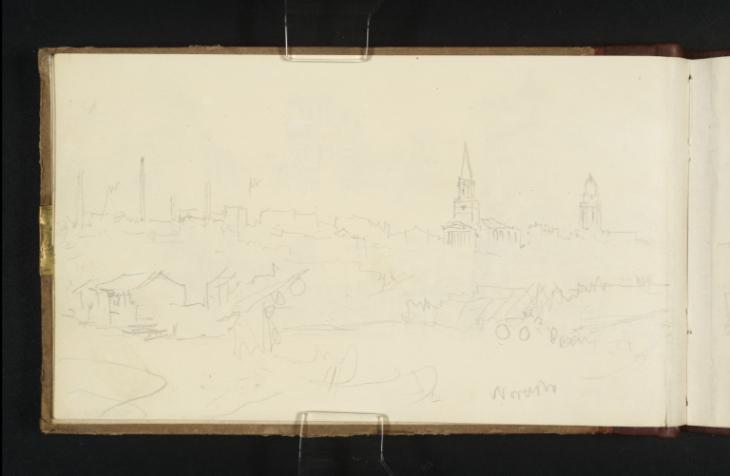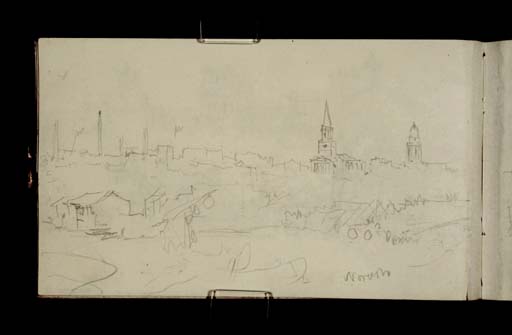J.M.W. Turner
>
1830-35 Annual tourist
>
Midlands 1830
>
Kenilworth Sketchbook
>
Artwork
Joseph Mallord William Turner Birmingham, with Christ Church and St Philip's Church from the Birmingham and Worcester Canal 1830
Image 1 of 2
Joseph Mallord William Turner,
Birmingham, with Christ Church and St Philip's Church from the Birmingham and Worcester Canal
1830
Joseph Mallord William Turner 1775–1851
Folio 3 Verso:
Birmingham, with Christ Church and St Philip’s Church from the Birmingham and Worcester Canal 1830
D21980
Turner Bequest CCXXXVIII 3a
Turner Bequest CCXXXVIII 3a
Pencil on white wove paper, 120 x 203 mm
Inscribed by Turner in pencil ‘Worcester’ bottom right and ‘[?w]’ twice above skyline centre left
Inscribed by Turner in pencil ‘Worcester’ bottom right and ‘[?w]’ twice above skyline centre left
Accepted by the nation as part of the Turner Bequest 1856
References
1909
A.J. Finberg, A Complete Inventory of the Drawings of the Turner Bequest, London 1909, vol.II, p.729, CCXXXVIII 3a, as ‘View of Oxford from near Osney (?).– “Worcester” (probably Worcester College)’.
This prospect of Birmingham shows the classical west front and spire of the early nineteenth-century Christ Church, New Street, from the south-west, with the Baroque St Philip’s Church (later Birmingham Cathedral) beyond; the Birmingham and Worcester Canal is in the foreground, in the vicinity of what is now Gas Street. Christ Church, demolished in 1899,1 stood on the site of Victoria Square, latterly west of the Town Hall and south of the Art Gallery. Later developments preclude any comparable view today. The drawing continues on folio 4 recto opposite (D41540) with some rather nondescript buildings in the middle distance.
Unusually, Finberg seems to have made an unforced error in suggesting that this view shows ‘Oxford from near Osney’, presumably prompted by Turner’s ‘Worcester’ inscription, which he thought ‘probably Worcester College’ was intended;2 the distant cluster of industrial chimneys on the left should perhaps have given him pause for thought. Before he died in 1939, he changed his mind, in line with the opinion of the watercolour and Turner scholar C.F. Bell (died 1966), in their similarly worded undated manuscript notes in copies of the Turner Bequest Inventory; they read the drawing as two panoramas, one above the other, the upper being Birmingham.3
Turner had produced a watercolour of Birmingham from the east in about 1794 (untraced),4 which was engraved in 1795 for the Copper-Plate Magazine (Tate impressions: T05890, T05891); although there is no evidence in his sketches that he visited the town at that time, Birmingham is mentioned among other Midlands subjects in notes at the beginning of the Matlock sketchbook, used in the summer of 1794 (Tate D00208; Turner Bequest XIX 2). James Hamilton has suggested that Turner’s 1830 visit might be connected with his works being exhibited there the previous year (see the introduction to the tour). Maps of the time show the urban centre as covering about a square mile. Hamilton notes that Birmingham had a population of 144,000 at this time, but in comparison with Manchester with its factories and Leeds with its mills, ‘Birmingham has always been perceived as a city of workshops rather than factories’, and ‘Turner characterized his views of Birmingham by sketching the towers of St Philip’s, St Martin’s-in-the-Bullring, and St Paul’s, Hockley’.5
Turner did not develop a watercolour view of Birmingham for his Picturesque Views in England and Wales, the main impetus of the 1830 Midlands tour (see the introductions to the sketchbook and tour). Tate D25250 (Turner Bequest CCLXIII 128), a hazy ‘colour beginning’ of an industrial town at sunset, may show Birmingham or perhaps nearby Dudley, which Turner did represent in a finished watercolour on a predominantly industrial theme, Dudley, Worcestershire of about 1832 (Lady Lever Art Gallery, Port Sunlight),6 engraved in 1835 for England and Wales (Tate impressions: T05097, T06113, T06114). For Dudley, see under folio 23 recto (D22016).
There are further views of Birmingham on folios 13 recto, 13 verso–14 recto, 14 verso–15 recto, 16 verso, 17 recto and verso, 18 verso–19 recto–19 verso–20 recto, 22 verso, 26 verso and 27 verso (Tate D21996–D22000, D22003–D22005, D22007–D22010, D22015 D22023, D22025). Others are in the contemporary Birmingham and Coventry sketchbook (see under Tate D22327; Turner Bequest CCXL 3).
Matthew Imms
August 2013
See William Dargue, ‘Christ Church, New Street’, A History of Birmingham Churches ... from A to Y, accessed 11 June 2013, http://ahistoryofbirminghamchurches.jimdo.com/birmingham-st-martin-in-the-bull-ring/christ-church-new-street/ .
A.J. Finberg, undated MS notes in a copy of Finberg 1909, Tate Britain Prints and Drawings Room, vol.II, p.729; C.F. Bell, undated MS notes in another copy at the same location, vol.II, p.729.
How to cite
Matthew Imms, ‘Birmingham, with Christ Church and St Philip’s Church from the Birmingham and Worcester Canal 1830 by Joseph Mallord William Turner’, catalogue entry, August 2013, in David Blayney Brown (ed.), J.M.W. Turner: Sketchbooks, Drawings and Watercolours, Tate Research Publication, September 2014, https://www


